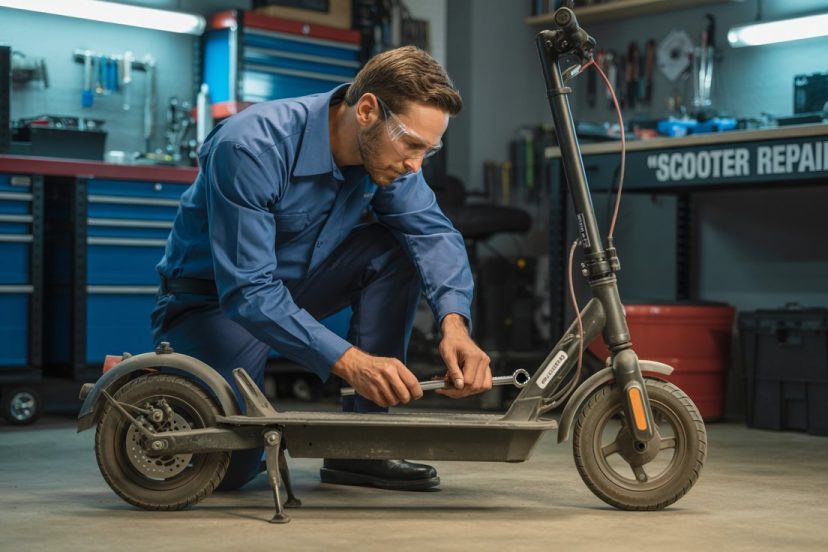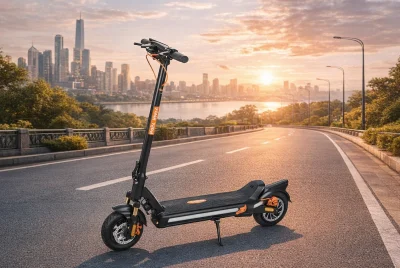DIY Electric Scooter Maintenance & Customization
*We may earn a commission for purchases made using our links. Please see our disclosure to learn more.
The rhythmic hum of an electric scooter gliding smoothly down the street represents more than just transportation—it embodies freedom, sustainability, and personal expression. For many riders, that perfect glide transforms into a frustrating wobble, a battery that dies mid-commute, or brakes that squeal embarrassingly at every stop. The difference between a reliable, personalized ride and a constant source of stress often comes down to one crucial factor: understanding how to maintain and customize your e-scooter yourself.
Electric scooters have revolutionized urban mobility, offering an eco-friendly alternative to cars and public transport. However, the true satisfaction comes not just from riding, but from developing the skills to keep your scooter running optimally and making it uniquely yours. This journey from basic ownership to confident DIY maintenance and creative customization opens up a world of possibilities that extends far beyond simple transportation.
“The best e-scooter is one that reflects your personality and runs exactly as you need it to. DIY maintenance isn’t just about saving money—it’s about building a relationship with your ride.”
– Electric Vehicle Maintenance Quarterly
Key Takeaways
- Preventive maintenance extends e-scooter lifespan by 2-3 years and prevents 80% of common mechanical failures
- Basic tool investment of $50-100 enables most DIY repairs and customizations, saving hundreds in professional service costs
- Regular cleaning and inspection routines take just 15 minutes weekly but prevent major component damage
- Battery care is the most critical factor, with proper maintenance extending battery life from 2-3 years to 4-5 years
- Safety modifications like upgraded lighting and reflective elements can reduce accident risk by up to 40%
- Performance customization allows riders to optimize speed, range, and comfort for their specific needs
The Journey into E-Scooter Mastery
Most e-scooter owners begin their journey with basic riding skills, but the real transformation happens when they discover the satisfaction of maintaining and personalizing their ride. This evolution typically starts with a simple problem—perhaps a flat tire or loose handlebars—that forces the rider to make a choice: pay for expensive repairs or learn to fix it themselves.
The path to DIY e-scooter mastery involves understanding three fundamental aspects: mechanical systems, electrical components, and safety considerations. Each area offers unique challenges and rewards, from the tactile satisfaction of perfectly adjusted brakes to the pride of a custom LED light display that makes your scooter instantly recognizable.
Essential Maintenance Fundamentals
Understanding Your E-Scooter’s Anatomy
Every e-scooter consists of several key systems that work together to provide smooth, safe transportation. The frame serves as the foundation, supporting the deck where riders stand and connecting the front and rear wheels. The steering mechanism includes the handlebars, stem, and folding mechanism, which must remain tight and properly aligned for safe operation.
The propulsion system centers around the electric motor, typically located in the front or rear wheel hub. This motor receives power from the battery pack, usually positioned on the deck or stem, through a network of wires and connectors. The throttle mechanism, whether thumb-operated or twist-grip style, controls the motor’s speed and acceleration.
Braking systems vary significantly between models, ranging from simple foot-operated rear fenders to sophisticated disc brakes with regenerative capabilities. Understanding which type your scooter uses is crucial for proper maintenance and potential upgrades.
Weekly Maintenance Rituals
Establishing a consistent weekly maintenance routine prevents small issues from becoming major problems. Begin each session by visually inspecting the entire scooter, looking for loose bolts, damaged components, or signs of wear. Pay particular attention to the folding mechanism, as this high-stress area often develops problems first.
Check tire pressure using a standard bicycle pump with a pressure gauge. Most e-scooter tires require 35-50 PSI, but always consult your owner’s manual for specific recommendations. Properly inflated tires improve range, handling, and comfort while reducing the risk of flats.
Clean the scooter thoroughly using a damp cloth, avoiding direct water exposure to electrical components. Focus on removing dirt and debris from the deck, wheels, and braking surfaces. For stubborn grime, use a mild soap solution, but never submerge any part of the scooter in water.
Test all electrical functions including lights, horn, and display screen. Charge the battery fully and note any changes in charging time or range performance, as these can indicate developing issues.
Monthly Deep Maintenance
Monthly maintenance sessions allow for more thorough inspections and adjustments. Begin by checking all visible bolts and screws, tightening any that have loosened due to vibration and use. Pay special attention to the stem folding mechanism, wheel axles, and brake components.
Inspect the brake pads or brake surfaces for wear. Disc brakes should have at least 2mm of pad material remaining, while drum brakes should show minimal scoring on the braking surface. Adjust brake tension as needed to maintain proper stopping power without excessive lever travel.
Examine the tires for embedded objects, uneven wear patterns, or sidewall damage. Remove any stones or debris lodged in the tread, as these can cause punctures over time. Check the tire tread depth—worn tires significantly reduce traction, especially in wet conditions.
Clean and inspect all electrical connections, looking for corrosion, loose wires, or damaged insulation. Use electrical contact cleaner to remove any oxidation from connectors, ensuring reliable power transfer throughout the system.
Battery Care and Optimization
The battery represents the heart of any e-scooter, and proper care directly impacts performance, range, and longevity. Most modern e-scooters use lithium-ion batteries, which have specific charging and storage requirements that differ significantly from older battery technologies.
Charging Best Practices
Avoid completely draining the battery whenever possible. Lithium-ion batteries prefer partial discharge cycles, with the ideal range being 20-80% charge. This practice can extend battery life by 50-100% compared to full discharge cycles.
Use only the manufacturer-provided charger or a certified replacement. Generic chargers may not provide the correct voltage or current profiles, potentially damaging the battery or creating safety hazards. Always charge in a well-ventilated area away from flammable materials.
Temperature significantly affects charging efficiency and battery health. Charge the battery at room temperature when possible, avoiding extreme hot or cold conditions. If the scooter has been in cold weather, allow it to warm up to room temperature before charging.
Storage Considerations
For long-term storage, maintain the battery at approximately 50% charge and recharge every 2-3 months to prevent deep discharge. Store the scooter in a cool, dry location away from direct sunlight and temperature extremes.
If storing for more than a month, disconnect the battery if possible to prevent parasitic drain from the scooter’s electronics. Some models include a storage mode that minimizes power consumption during extended periods of non-use.
Tire and Wheel Maintenance
Tires represent one of the most critical safety components, directly affecting traction, handling, and comfort. Regular inspection and maintenance prevent most tire-related problems and ensure optimal performance.
Tire Inspection Techniques
Examine tires weekly for embedded objects, cuts, or bulges that could indicate internal damage. Remove any visible debris using needle-nose pliers, being careful not to damage the tire casing. Small punctures can often be repaired using standard bicycle tire patches or tire plugs.
Check for even wear patterns across the tire surface. Uneven wear may indicate alignment issues, improper inflation, or suspension problems that require attention. Front and rear tires typically wear at different rates due to different loads and usage patterns.
Monitor tire pressure regularly, as under-inflated tires increase rolling resistance, reduce range, and increase puncture risk. Over-inflated tires provide less traction and a harsher ride while being more susceptible to impact damage.
Wheel Bearing Maintenance
Wheel bearings allow smooth rotation and support the scooter’s weight. Worn bearings create noise, vibration, and potential safety hazards. Test bearing condition by spinning each wheel freely—smooth, quiet rotation indicates good condition, while grinding or roughness suggests replacement is needed.
Most e-scooter bearings are sealed units that don’t require regular lubrication, but they should be inspected for play or looseness. Excessive wheel wobble indicates bearing wear and requires immediate attention.
Brake System Optimization
Effective braking is crucial for safety and confidence, yet many riders neglect brake maintenance until problems develop. Understanding your scooter’s brake system enables proper adjustment and timely maintenance.
Disc Brake Maintenance
Disc brakes offer superior stopping power and heat dissipation compared to other systems. Inspect brake pads regularly for wear, glazing, or contamination. Glazed pads appear shiny and provide reduced braking power—light sanding can restore their effectiveness.
Check brake disc condition for scoring, warping, or contamination. Clean discs with isopropyl alcohol to remove oil or debris that reduces braking effectiveness. Severe scoring or warping requires disc replacement.
Adjust brake lever reach and tension to match your hand size and preference. Proper adjustment allows full braking power with comfortable lever travel and reduces hand fatigue during long rides.
Drum Brake Care
Drum brakes, while less common, offer protection from weather and debris. These systems require periodic adjustment as the brake shoes wear and the cable stretches. Most drum brake systems include adjustment mechanisms that compensate for wear.
Inspect brake cables for fraying, kinking, or corrosion. Replace damaged cables immediately, as brake failure can occur suddenly. Lubricate cable housings with light oil to ensure smooth operation.
Customization and Personal Expression
Beyond basic maintenance, customization allows riders to personalize their e-scooters for improved performance, comfort, and style. These modifications range from simple aesthetic changes to complex performance upgrades.
Lighting and Visibility Upgrades
Enhanced lighting improves safety while adding personal style. LED strip lights, custom headlights, and underglow systems create distinctive looks while increasing visibility. Ensure all lighting modifications comply with local regulations regarding color and positioning.
Reflective tape and decals provide passive safety benefits without electrical complexity. Strategic placement on the deck, stem, and wheels creates highly visible patterns that help other road users see the scooter from multiple angles.
Comfort Modifications
Handlebar grips significantly impact comfort and control. Ergonomic grips reduce hand fatigue and provide better grip in wet conditions. Choose grips that match your hand size and riding style—lock-on grips offer superior security compared to slip-on designs.
Deck modifications include grip tape patterns, cushioned pads, and platform extensions. These changes improve comfort and control while adding personal style. Ensure any deck modifications don’t interfere with the folding mechanism or safety features.
Performance Enhancements
Tire upgrades can dramatically improve performance, comfort, and safety. Wider tires provide better stability and comfort, while specialized tread patterns enhance traction in specific conditions. Ensure replacement tires match the original specifications for load capacity and speed rating.
Suspension upgrades, where possible, improve comfort and handling on rough surfaces. Some scooters accept aftermarket shock absorbers or spring modifications that provide better damping and adjustability.
Troubleshooting Common Issues
Developing diagnostic skills enables quick identification and resolution of problems. Most e-scooter issues fall into predictable categories with standard solutions.
Electrical Problems
Intermittent power loss often indicates loose connections or corroded contacts. Systematically check all electrical connections, cleaning and tightening as needed. Use electrical contact cleaner to remove oxidation from connectors.
Display or control issues may stem from water damage or component failure. Protect electrical components from moisture using clear tape or purpose-made covers. If problems persist after cleaning connections, professional diagnosis may be required.
Mechanical Issues
Unusual noises during operation usually indicate mechanical problems. Grinding sounds suggest bearing wear, while clicking or ticking may indicate loose components. Identify the source of noise by listening carefully while manually operating different systems.
Vibration or instability often results from loose bolts, worn bearings, or damaged wheels. Perform a systematic inspection of all mechanical components, paying particular attention to high-stress areas like the folding mechanism and wheel attachments.
Safety Considerations and Best Practices
DIY maintenance and customization must prioritize safety above all other considerations. Understanding potential hazards and implementing proper safety practices prevents injuries and ensures reliable operation.
Tool Safety and Technique
Use appropriate tools for each task, as improvised tools can damage components or cause injury. Invest in quality tools that match your scooter’s hardware—metric tools for most modern scooters, imperial tools for some older models.
Follow proper lifting and support techniques when working on the scooter. Use a stable work surface at appropriate height to prevent back strain and ensure good access to components. Never work under a scooter supported only by the kickstand.
Modification Limits
Understand the limitations of your scooter’s design and avoid modifications that exceed these limits. Increasing speed or power beyond manufacturer specifications can overstress components and create safety hazards. Always consider the impact of modifications on warranty coverage.
Document all modifications for future reference and potential warranty claims. Take photos before and after modifications to track changes and facilitate restoration if needed.
Advanced Customization Projects
Experienced DIY enthusiasts can tackle more complex modifications that significantly enhance performance and functionality. These projects require advanced skills and tools but offer substantial rewards.
Electronic Modifications
Custom lighting controllers enable sophisticated lighting patterns and effects. These systems can integrate with braking and turning signals for enhanced safety. Programming skills and electronic knowledge are required for complex installations.
Performance tuning through controller modifications can optimize power delivery and efficiency. These changes require understanding of electronic systems and may void warranties. Always research compatibility and safety implications before proceeding.
Mechanical Upgrades
Suspension system modifications can dramatically improve comfort and handling. Custom shock absorbers, springs, and damping systems transform the riding experience but require precise fitting and adjustment.
Drivetrain modifications, including gear ratios and motor upgrades, can optimize performance for specific applications. These changes require careful consideration of power requirements, heat generation, and component compatibility.
Building a DIY Community
Connecting with other DIY enthusiasts provides valuable knowledge sharing and support. Online forums, local meetups, and social media groups offer resources for troubleshooting, modification ideas, and safety advice.
Knowledge Sharing
Document your projects and share experiences with others. Detailed photos, step-by-step instructions, and honest assessments of results help other enthusiasts avoid common mistakes and achieve better results.
Seek advice from experienced mechanics and electrical technicians when tackling complex projects. Professional guidance can prevent costly mistakes and ensure safe installations.
Tool and Resource Sharing
Organize tool-sharing arrangements with other enthusiasts for specialized equipment that’s used infrequently. This cooperation makes expensive tools accessible while building community connections.
Bulk purchasing of common maintenance items like brake pads, tires, and lubricants reduces costs while ensuring quality components are readily available when needed.
Economic Benefits of DIY Maintenance
Developing DIY skills provides significant economic advantages beyond simple repair cost savings. Understanding these benefits helps justify the time and effort required to master maintenance and customization techniques.
Cost Analysis
Professional e-scooter service typically costs $50-150 per visit, depending on the complexity of work required. Basic maintenance items like tire changes, brake adjustments, and cleaning can be performed at home for a fraction of this cost.
Tool investment pays for itself quickly through reduced service costs. A comprehensive tool kit costing $100-200 enables most maintenance and modification tasks, typically recovering its cost within the first year of ownership.
Value Preservation
Well-maintained e-scooters retain significantly more value than neglected ones. Regular maintenance preserves both mechanical condition and cosmetic appearance, important factors in resale value.
Documentation of maintenance history increases buyer confidence and justifies higher selling prices. Detailed records demonstrate responsible ownership and proper care.
Environmental Impact and Sustainability
DIY maintenance and customization contribute to environmental sustainability by extending product life cycles and reducing waste. Understanding these impacts reinforces the value of developing maintenance skills.
Lifecycle Extension
Proper maintenance can double or triple an e-scooter’s useful life, dramatically reducing the environmental impact per mile traveled. This extension delays the need for replacement, conserving resources and reducing manufacturing demands.
Component-level repairs and upgrades prevent entire units from entering waste streams. Replacing worn parts instead of discarding complete scooters minimizes environmental impact while maintaining performance.
Waste Reduction
DIY repairs often salvage components that would otherwise be discarded. Creative reuse of parts, combined with proper recycling of truly worn components, minimizes waste generation.
Customization using existing components reduces demand for new parts while creating unique, personalized results. This approach combines environmental responsibility with creative expression.
Future Trends and Developments
The DIY e-scooter maintenance and customization field continues evolving with new technologies, techniques, and components. Understanding these trends helps enthusiasts prepare for future opportunities and challenges.
Technology Integration
Smart diagnostic systems increasingly enable precise problem identification and performance optimization. These systems provide real-time data about component condition and performance, enabling proactive maintenance.
Modular designs simplify customization and repair by standardizing component interfaces. This trend makes advanced modifications accessible to more enthusiasts while improving reliability.
Component Availability
Aftermarket component availability continues expanding, providing more options for performance upgrades and customization. This growth enables more sophisticated modifications while reducing costs.
3D printing technology makes custom parts accessible to home enthusiasts, enabling unique modifications that were previously impossible or prohibitively expensive.
Conclusion
The journey from basic e-scooter ownership to confident DIY maintenance and creative customization represents a transformation that extends far beyond simple transportation. This evolution develops valuable technical skills, provides economic benefits, and creates opportunities for personal expression while contributing to environmental sustainability.
Success in DIY e-scooter care requires patience, attention to detail, and commitment to safety. The reward is a deeper understanding of your ride, the satisfaction of self-reliance, and the ability to create a truly personalized transportation solution that reflects your needs and preferences.
Whether you’re drawn to the mechanical satisfaction of perfect brake adjustment, the creative challenge of custom lighting design, or the economic benefits of self-maintenance, the world of DIY e-scooter care offers something for every enthusiast. The skills developed through this journey often transfer to other areas of life, creating a foundation for lifelong learning and problem-solving.
The path ahead is filled with opportunities to learn, create, and connect with fellow enthusiasts who share your passion for these remarkable machines. Each successful repair, thoughtful modification, and shared experience contributes to a growing community of riders who understand that the best e-scooter is one that you’ve made your own through knowledge, skill, and creativity.
Remember that every expert was once a beginner, and every complex modification started with mastering the basics. Embrace the learning process, celebrate small victories, and don’t hesitate to seek help when needed. The DIY e-scooter community is remarkably supportive, with experienced enthusiasts eager to share knowledge and encourage newcomers.
Your e-scooter is more than just a mode of transportation—it’s a canvas for creativity, a platform for learning, and a gateway to a community of like-minded individuals who understand that the journey is just as important as the destination.
Frequently Asked Questions
Q: How often should I perform basic maintenance on my e-scooter?
A: Perform basic maintenance weekly, including visual inspection, tire pressure check, and cleaning. Monthly sessions should include thorough bolt checking, brake inspection, and electrical connection cleaning. Battery maintenance should be ongoing with proper charging practices and storage procedures.
Q: What tools do I need to get started with DIY e-scooter maintenance?
A: Essential tools include a multi-tool with metric hex keys, adjustable wrench, tire pressure gauge, basic cleaning supplies, and electrical contact cleaner. Additional tools like torque wrenches and specialized brake tools can be added as your skills develop. A basic toolkit costing $50-100 covers most maintenance needs.
Q: Can I modify my e-scooter without voiding the warranty?
A: Most modifications will void manufacturer warranties, especially those affecting electrical systems or structural components. Check your warranty terms carefully and consider waiting until warranty expiration for major modifications. Some cosmetic changes like grips or decals may not affect warranty coverage.
Q: How do I know if a problem requires professional repair versus DIY fixing?
A: Attempt DIY repairs for mechanical issues you understand, electrical problems limited to connections and cleaning, and cosmetic modifications. Seek professional help for complex electrical diagnosis, structural damage, motor problems, or any issue where safety is uncertain. When in doubt, consult a professional.
Q: What’s the most important maintenance task for extending e-scooter life?
A: Proper battery care has the greatest impact on overall e-scooter longevity and performance. This includes using correct charging practices, avoiding extreme temperatures, maintaining proper charge levels, and protecting from moisture. Since battery replacement is often the most expensive repair, proper care provides the best return on maintenance investment.




